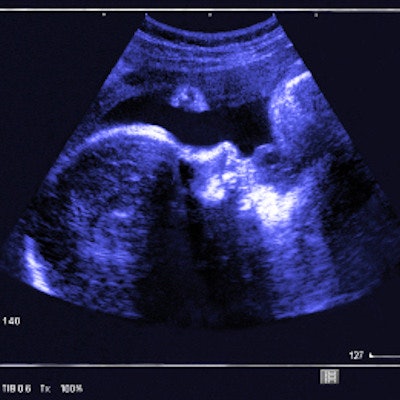
Cervical changes can be seen between pregnant and nonpregnant women via strain elastography, according to findings presented March 28 at UltraCon.
Presenter Dr. Nora Doyle from University of Texas Health Science Center at San Antonio shared her team's findings, which showed significant changes in cervical tissue consistency and density when comparing the pregnant and nonpregnant cervix.
"Practitioners may be able to use this as a screening tool for preterm birth and other interventions like cerclage placement to save a pregnancy," Doyle told AuntMinnie.com.
Transvaginal ultrasound (TVUS) is commonly used to look at cervical changes throughout a pregnancy. Previous studies have suggested that elastography is useful in assessing human tissues in several medical specialties, but Doyle noted that it hasn't been used much in obstetrics.
The researchers sought to compare the tissue consistency differences in pregnant and nonpregnant cervixes using strain elastography. They assessed 111 cervical measurements collected between 2019 and 2020; of these, 68 were gathered from pregnant women and 43 from nonpregnant women. For the pregnant women, 55 were singleton and 13 were twin pregnancies.
The team found significant differences between pregnant and nonpregnant cervixes in several measurements.
| Comparison between pregnant, nonpregnant women | ||
| Measurement | Nonpregnant women | Pregnant women |
| Cervical length | 2.83 cm | 3.83 cm |
| Hardness ratio | 91.3% | 59.5% |
| Elasticity contrast index | 2.73 | 4.17 |
| Internal Os strain | 0.12 | 0.28 |
| External Os strain | 0.13 | 0.31 |
The researchers also noted that these differences held true through all pregnancy trimesters. They also found no significant difference in the ratio of internal os strain and external os strain between pregnant and nonpregnant women (p = 0.99).
The study showed that women pregnant with twins had cervical tissue that was less dense than cervical tissue for those with a singleton pregnancy and for women who were not pregnant. This included an average cervical length of 4.09 for twin pregnancies, as well as a hardness ratio of 57.1%.
However, the team found no significant difference in the ratio of internal os strain and external os strain between women carrying a singleton pregnancy and nonpregnant women, or between women carrying twins and nonpregnant women.
Doyle's group plans to more data to construct a cervical nomogram in pregnancy, she said.




















